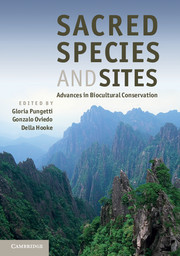Book contents
- Frontmatter
- Contents
- List of Contributors
- Foreword
- Preface
- Acknowledgements
- Introduction
- Part I Concepts and Knowledge
- Part II Sacred Landscapes
- Part III Sacred Sites and People
- Part IV Sacred Species
- 13 The conservation status of sacred species: a preliminary study
- 14 The role of taboos and traditional beliefs in aquatic conservation in Madagascar
- 15 Sacred species of national marine sanctuaries of the United States’ West Coast
- 16 Integrating biocultural values in nature conservation: perceptions of culturally significant sites and species in adaptive management
- Part V Sacred Animals
- Part VI Sacred Groves and Plants
- Part VII Implementation and Conclusions
- Index
- Plate Section
- References
16 - Integrating biocultural values in nature conservation: perceptions of culturally significant sites and species in adaptive management
from Part IV - Sacred Species
Published online by Cambridge University Press: 05 August 2012
- Frontmatter
- Contents
- List of Contributors
- Foreword
- Preface
- Acknowledgements
- Introduction
- Part I Concepts and Knowledge
- Part II Sacred Landscapes
- Part III Sacred Sites and People
- Part IV Sacred Species
- 13 The conservation status of sacred species: a preliminary study
- 14 The role of taboos and traditional beliefs in aquatic conservation in Madagascar
- 15 Sacred species of national marine sanctuaries of the United States’ West Coast
- 16 Integrating biocultural values in nature conservation: perceptions of culturally significant sites and species in adaptive management
- Part V Sacred Animals
- Part VI Sacred Groves and Plants
- Part VII Implementation and Conclusions
- Index
- Plate Section
- References
Summary
Introduction
Ecosystems not only consist of physical attributes, they are subjected to and influenced by cultural perceptions and values. As Schama notes, ‘Landscapes are culture before they are nature; constructs of the imagination projected onto wood water and rock’ (1995, p. 61). Schama goes further by stating that there is an elaborate frame through which our adult eyes survey the landscape and that before landscape can ever be a response for the senses, it is the work of the mind. This leads Schama to conclude that the landscape's scenery is built up as much from strata of memory as from layers of rock. Hence, cultural perceptions and shared history of landscapes result in different and even contesting meanings of ecosystems and landscapes (Stewart and Strathern, 2003; Mainteny, 2004).
In some cultures the spiritual values of certain sites and species may be important enough for local people to conserve and protect the ecosystems that contain them. This occurs, even though an economic cost–benefit analysis may advise conversion of the ecosystem through resource development, such as mining or agriculture. To those people, the spiritual significance of rivers, mountains, or even individual tree or animal species such as the black-necked crane mentioned further on in this chapter, has led to their veneration and recognition as sacred (Verschuuren et al., 2010). Those sacred sites and species are increasingly known for their significant contribution to biodiversity values (Stewart and Strathern, 2003; Dudley et al., 2005; Putney, 2005; Bhagwat and Rutte, 2006; Verschuuren et al., 2010). Sacred places are often traditionally managed based on ancestral intergenerational principles that in many cases ensure cultural continuity and environmental management (Berkes, 1999; Jeanrenaud et al., 2001; Verschuuren, 2006). The cultural and spiritual importance of sacred sites and species is often ignored in Western-style landscape and ecosystem management. This chapter investigates the role of sacred sites and species in new emerging biocultural approaches in nature conservation and ecosystem management.
- Type
- Chapter
- Information
- Sacred Species and SitesAdvances in Biocultural Conservation, pp. 231 - 246Publisher: Cambridge University PressPrint publication year: 2012
References
- 3
- Cited by



